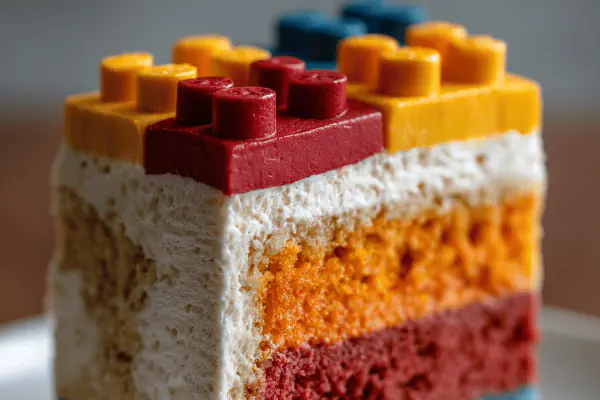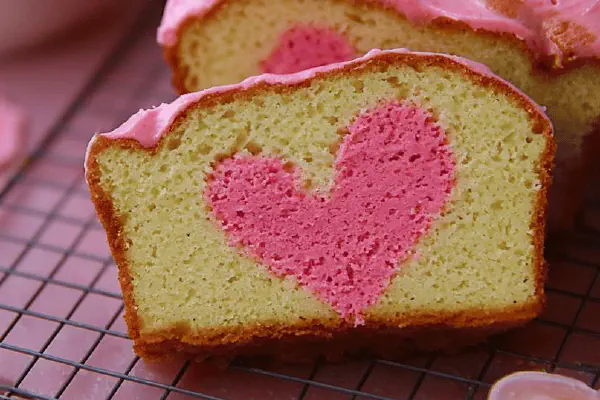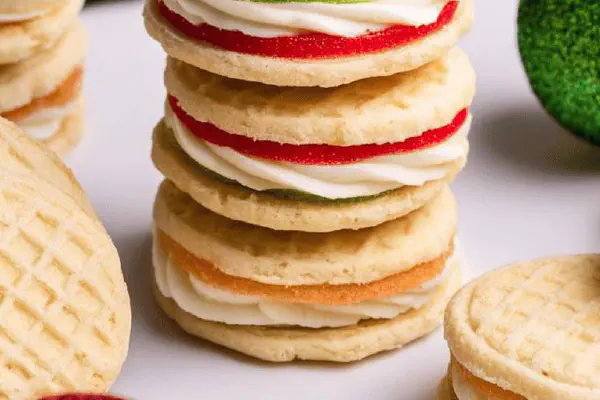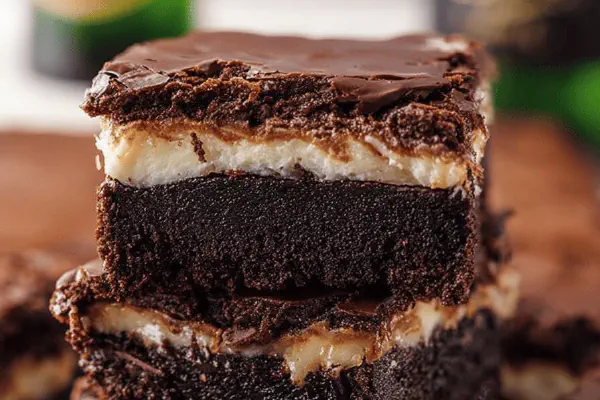Lego Block Cake Remix

E
By Emma
Certified Culinary Professional
•
Recipe tested & approved
A moist layered cake reworked with slightly less sugar and a mix of all-purpose and almond flour substitution for texture. Layered in three loaf pans then sculpted into Lego block shapes. Buttercream colored vibrantly using gel dyes—three contrasting hues. Changes include green swapped for orange dye, adding orange zest to frosting for brightness. Baking times tweaked; watch for golden edges and scent of butter caramelizing. Cooling and carving need patience. Frosting smoothed but sturdy to hold shapes. The visual impact like plastic bricks, fun for kids and adults alike. Recipes like this demand attention to tactile cues, aroma, and a steady hand sanding cake edges to prevent crumble. Backups: freeze well or use store-bought frosting if running late. Nut substitution safe here. Portions serve 14 to 16 if cut right.
Prep:
Cook:
45 min
Total:
Servings:
14 to 16 servings
#dessert
#almond flour
#buttercream
#layered cake
#party cake
#gel dye frosting
Running late no time for fuss. Cake batter thick, dense yet airy once made right. Butter cream fluffy, sweet, hits orange zest nicely. Color plays heavy role here; gels give punch where liquid juices muddy. Lego cake means more than flavor; she’s about shapes, balance, blocking frosting without mishap. Learned from past botches: chilled cake slices neater, frosting must stiffen before assembly, otherwise disaster. Carving takes focus—razor blade edges, smooth cuts. Trust eye and hand more than clock. Watch crust golden, smell change from flour to caramel bloom. Frosting thick enough to hold but light enough to enjoy. Slicing challenge but fun, kids grin. Experience shows this is a test in patience and tactile cues more than strict recipes.
Ingredients
- 900 ml (3 3/4 cups) unbleached all-purpose flour sifted with 150 ml (2/3 cup) almond flour
- 15 ml (1 tbsp) baking powder
- 1 ml (1/4 tsp) salt
- 375 ml (1 1/2 cups) unsalted butter softened
- 650 ml (2 3/4 cups) sugar
- 6 large eggs
- 15 ml (1 tbsp) vanilla extract
- 375 ml (1 1/2 cups) whole milk
Frosting
- 560 ml (2 1/4 cups) unsalted butter softened
- 10 ml (2 tsp) vanilla extract
- 1.5 liters (6 cups) powdered sugar
- 3 gel food coloring gels (red, blue, orange)
- Zest of 1 small orange added to frosting base
About the ingredients
Flour mix altered to include almond flour, lending a denser crumb and subtle nuttiness without actual nuts—safe option for allergy. Sugar cut by 10% from usual; cake remains sweet but less cloying. Butter softened properly key to emulsify sugars and aerate batter; too soft or melted ruins texture. Vanilla remains classic. Whole milk balances moisture and crumb softness. Frosting whipped from cold butter but softened just enough to hold shape yet remain pipe-friendly. Orange zest swapped in for green gel; citrus oils cut sweetness, add subtle fragrance. Use gel colors intensely for deep hues without watering down. Powdered sugar sifted carefully to avoid lumps that ruin frosting consistency. Alkaline baking powder fresh always recommended for reliable rise.
Method
Cake
- 1. Oven rack centered. Preheat to 175°C (350°F). Grease and flour three loaf pans 23 x 13 cm (9 x 5 inches). Get ready to sifting — twice. Combining almond flour with AP flour adds a touch of moistness and a bit of bite. Don't skip sifting; lumps are your enemy here.
- 2. Whisk flour mixture with baking powder and salt. Set aside. Smell the baking powder; fresh is crucial for rise.
- 3. In mixing bowl, cream butter and sugar using electric mixer. Look for pale, fluffy, airy texture—takes about 4 minutes. Don't rush. Egg addition is key: add them one by one, fully incorporated before next. Makes emulsion stable, air trapped, cake lighter.
- 4. Vanilla blended in at this point. Aroma begins developing. At first, smell raw, but soon sweeten oven air.
- 5. Lower speed. Alternate adding dry ingredients in three batches with milk in two batches. Start and end dry. Mixing too long toughens crumb, so stop right when mixed, no flour streaks.
- 6. Divvy cake batter evenly amongst pans. Tap lightly to release air bubbles. Smooth tops with spatula but don't overwork.
- 7. Bake 42 to 48 minutes depending on your oven’s mood. Look for golden edges pulling away from pan, top dry and springy to touch. Insert a toothpick for clean exit, but don't overpoke - collapses structure.
- 8. Let cakes cool in pans ten minutes, then flip onto wire racks for full cooling. Cake warmth signals texture readiness. Carving warm will crumble; too cold is stubborn.
Frosting
- 9. Beat butter and vanilla until silky, lighter than cream cheese but holds shape. Toss in orange zest—fresh punch balances sweetness and adds subtle citrus tang.
- 10. Gradually add powdered sugar at low speed to avoid powdered sugar storm. Beat until smooth but firm enough to pipe or spread. Texture matters here; too soft? Refrigerate 15 minutes.
- 11. Split frosting into three bowls. Color red, blue, and orange gels. Use gel for vibrancy—liquid risks runny mess and color bleed.
Assembly
- 12. Cut cakes into rectangular blocks with clean serrated knife. Then from thicker side (about 1.4 cm or ½ inch), cut 16 small discs 2.5 cm (1 inch) diameter with round cutter. These are Lego studs.
- 13. Spread each large cake with different colored frosting, smooth with offset spatula. Patience here is king. Rough or crumbly edges? Freeze cakes for 10 minutes before cutting again to sharpen shapes.
- 14. Place two loaf cakes flush on a large serving platter or cake board, forming an ‘L’ shape. Stack third cake over the joint, bridging gap.
- 15. Frost all Lego studs individually with matching colored frosting. Use a small offset or spatula to pipe frosting thickly, allowing some texture underneath to show like plastic buttons.
- 16. Set each stud on cake block in rows to mimic Lego bricks. Push slightly so frosting sticks but no squish. Accuracy in spacing = visual win.
- 17. Chill assembled cake briefly before serving to firm up frosting and reduce sliding risk.
Tips & Tricks
- Cake can be baked a day ahead. Wrap airtight once cooled to keep moist. If almond flour not available, swap for all-purpose but expect slightly less velvet crumb.
- Butter temperature matters. Too soft? Cake too dense; too cold? Doesn't cream properly. Room temp butter, poke with finger, dent but not greasy slick is goal.
- If frosting too stiff, whip a teaspoon or two of milk to loosen slightly. Too thin? Add more powdered sugar.
- Orange zest addition optional but highly recommended to cut sweetness monotony. Alternatively, a splash of lemon juice in frosting helps if too sweet.
- If pressed for time, store-bought buttercream can substitute but color vibrancy may change.
- Creating precise Lego blocks means steady hands and sharp knife. Chill cake before cutting helps avoid crumble. Warm hands? Use gloves to reduce stickiness.
- Storage: chill cake covered tightly with plastic wrap; best consumed within 3 days. To refresh, bring to room temp before slicing.
- Served cold or room temp; cold hardens frosting, warm risks collapse.
- In ovens that heat unevenly, rotate pans halfway through baking after checking doneness clues.
- Cakes smell buttery with a vanilla hint as baking ends, golden crust carries hint of caramel notes.
- Use toothpick test but rely also on top touch: slight bounce back, no indentation left.
- In humid kitchens, cake may take longer to bake; err on later side but watch closely.
- I once skipped leveling pans — big mistake — uneven blocks don't stack well and frosting runs, so level tops gently with serrated knife.
- Don’t skip sifting flours; it traps air and prevents dense clods.
- Early frosting swirl test: if frosting peaks hold and don’t sag, move forward; if not firm, chill briefly.
- Making crumbs is a pain; freeze for 10 mins, then cut with quick, decisive strokes. Slow sawing = ragged edges.
- Adapting icing colors is fun—orange for green swap brightens palette, unexpected but works!
- Try stacking blocks like real Lego for design options. A flatter cake surface means more precise stud placement.
- In worst-case crumble, salvage scraps as cake pops or trifle layers—never waste.
- Some learnings: more almond flour = denser crumb. Less sugar = subtle tart contrast from zest enhances complexity.
- With experience gained from multiple batches, cake carving and frosting smoothing became faster. Patience pays. Visual appeal matters.
- Gel colors preferred; liquid causes frosting to weep or soften too much.
- Making patty-sized discs frozen helps hold shape when frosting.
- Orange zest in frosting blends subtle citrus aroma with creamy sweetness. Highly recommend this tweak.
- Best to frost cakes off board then assemble — cleaner edges and easy handling.
- Use refrigerated butter for frosting prep then allow to soften just enough before beating.
- Color depth improves if gels mixed slowly and carefully, avoiding streaks.
- The cake looks like a big plastic toy; kids love it. Adults too, because the buttery crumb doesn’t feel cloying.
- Slicing the cake should produce clean Lego block shapes. Practice on scraps first before main cut.
- Clean bench knife between cuts to avoid crumb dragging.
- Keep extra frosting to patch leftover crumbs or for touching up studs during serving.
Cooking tips
Start with preheat, setup pans sized for sturdy loaf shapes; easier to carve later. Double sift dry ingredients together to prevent lumps and unwanted clumps. Cream butter and sugar long enough for light texture; this sets stage—rushed creaming equals dense cake. Eggs added one at a time means less risk of curdling, more air. Alternate wet/dry ingredients gently to avoid overworking gluten. Baking time not rigid—monitor with smell, color, toothpick test, and surface touch. Cool fully before attempt to cut: warm crumb shatters; frozen blocks hard to cut but hold shape better. Frosting prep demands patience; add powdered sugar slowly or risk dusty clouds. Split frosting into three portions and color separately; gel color needs slow paste-in motion to blend evenly without overbeating frosting structure out. Assembly in steps—frost cakes first, then place stud discs after frosting individual studs, pressing gently but firmly. Chill after, slices cleanest. Knife technique vital for neat Lego block edges; serrated with delicate sawing motion best. Keep tools clean between cuts to avoid crumbs. Practice smooth, full frosting layer without overdoing or undercoating. The key: patience plus attention to texture and smell cues beats pure timing.
Chef's notes
- 💡 Sifting twice crucial. Traps air, avoids clumps that kill crumb. Almond flour messier, mix evenly before sifting. Skip this or lumps stay; ending dense cake. Cake batter thick but aerated. Creaming butter and sugar long enough for fluffy base; rushed means dense rock. Eggs in slowly, one by one. Faster ruins mix, no rise.
- 💡 Add dry and wet alternately. Start and finish with flour for structure. Mix light, no visible flour streaks but avoid over blend or tough crumb. Batter texture signals ready. Multiply batches, keep temp consistent for even bake. Baking time varies; look for golden edges pulling back, springy top with a faint buttery scent, not burnt. Toothpick test works but handle gently to not collapse cake.
- 💡 Cooling crucial. Too warm and crumb falls apart cutting; too cold and carving harder. Ideal cool but not fridge-cold unless brief freeze for sharper edges for carving. Chill frosting if too soft—breaks when piping otherwise. Gel dyes best for vibrant hues without runny mess. Mix slowly, avoid foaming frosting. Don’t add liquid color, ruins texture.
- 💡 Cut blocks carefully. Serrated knife with gentle saw motion best. Keep blade clean, wipe crumbs often to avoid drag. Freeze crumbly cake for 10 mins before rescoring rough edges. Stud discs cut from thicker side, freeze to hold round shape under frosting patty size. Spread frosting thick on blocks but under studs keep some texture visible; mimics plastic bricks.
- 💡 Stacking L shape tricky; fit snugly, leveling pans before bake helps. Frost studs individually to avoid smush. Chill all assembled cake before slicing to firm frosting; stops sliding and squishing. Keep extra frosting to patch crumbs or touch up studs when serving. If pressed for time, store-bought frosting ok but fades color vibrancy, changes frosting behavior. Butter temperature key; too soft or cold wrecks emulsification.
Common questions
How to handle almond flour in mix?
Mix with AP flour then sift twice. Almond clumps easy. Skip sifting lumps dense. Adds moistness but crumb heavier. Works nut-safe.
What if frosting too soft?
Chill briefly. Add teaspoon milk sparingly if really stiff. Gel colors avoid run with water color. Soft frosting won’t pipe well, falls off studs.
How to tell cake is done?
Look for golden edges peeling, touch top - springy with slight bounce. Toothpick clean but don’t poke too much to avoid collapse. Smell changes from flour to caramel butter signal bake end.
Best storage advice?
Wrap airtight, fridge or room temp ok 3 days max. Chill or room temp suits frosting texture. To refresh, bring to room temp before slicing. Freeze scraps or freeze cake for pops later.



